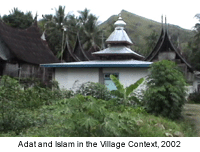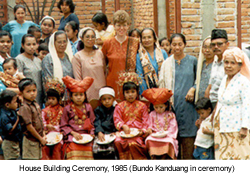 |
 |
 |
| |
|
|
|
|
|
MATRIARCHY
& ISLAM POST
9/11:
THE CASE OF THE MINANGKABAU OF INDONESIA
CONTRIBUTION FROM: DEVOTEE RICK

By: Peggy Reeves
Sanday
Professor of Anthropology
http://www.asiasource.org/asip/sanday.cfm
The distinction made in Indonesia and elsewhere between political Islam (also called Islamism) and cultural Islam puts into sharp relief the reality that in many parts of the Islamic world communities subscribing to the "five pillars" of Islamic practice also live in syncretism with traditions that can be traced to centuries-old pre-Islamic traditions. Like Christianity and many of the world's other religious traditions, the spread of Islam was due to its ability to accommodate not abolish local tradition.
THE CASE OF THE MINANGKABAU
The importance of separating cultural from political Islam is highlighted by
the case of the Minangkabau. One of the largest ethnic groups in Indonesia,
numbering some four million in their homeland province of West Sumatra, the
Minangkabau are famous in Indonesia for their matrilineal social system and
dedication to Islam. From 1981 to 1999 I visited West Sumatra nearly every year
to study what the Minangkabau refer to as adat matriarchaat. This term refers
to the matriarchal customs men and women associate with the highly codified
pre-Islamic cultural tradition called adat Minangkabau. Because of the association
the Minangkabau make between Islam and adat - saying that the two are inseparable
- one is faced with explaining how the supposedly patriarchal Islam came to
be tied to a matriarchal cultural system. This is especially pertinent in the
post-9/11 world when Islam is increasingly associated with the subordination
of women and is politicized through terrorism.
My recently published ethnography of the Minangkabau, Women at the Center: Life in a Modern Matriarchy (2002), presents a conceptual framework for rethinking matriarchy. Based on observing adat matriarchaat in village life, I critique the Western definition of matriarchy as female rule. Defining matriarchy as the mirror image of patriarchy is based on two faulty assumptions: first, that women must be like men to occupy a central position in society, and secondly, that the core of social life revolves around governance as we know it. Such assumptions are not compatible with much that anthropologists have learned about the hegemony of custom and tradition. If custom and tradition rule, then we must look at culture, not politics, for female-oriented social systems.
In the Minangkabau case matriarchy is a system of interlocking public symbols and ritual practices focused on the maternal household, clan land, and the life cycle. Adat matriarchaat constitutes an ethos and worldview grounded in an egalitarian social system backed by custom and tradition in which neither sex rules as a class over the other. For example, although males are in charge of the public arbitration of disputes, their decisions reflect a community consensus which includes both sexes. From the Minangkabau case I conclude that the key to matriarchy is in cultural systems constituted by first principles and dominant symbols rooted in maternal meanings.
Returning to West Sumatra in the post-Suharto Era After West Sumatra was granted autonomy in the post-Suharto era and the 9/11 disaster hit, I was naturally curious about whether either had a significant impact on matriarchal customs or on Islam in the village where I had lived. In telephone conversations with friends in West Sumatra, I learned that local autonomy had produced an adat renaissance as villages returned en masse to the adat village system that had been abolished by Suharto's regime. In the aftermath of 9/11, it was clear that the U.S. media focus on Indonesian Islamism did not apply to what was happening in West Sumatra.
To find out more, I returned to West Sumatra in July of 2002. Everything I learned during this trip supported and amplified the conclusions of the book regarding the enduring strength of the relationship between adat and Islam.
ADAT & ISLAM IN THE VILLAGE CONTEXT
My analysis is grounded in the village context of the
highland area of West Sumatra, known as the heartland of Minangkabau culture,
where adat is said to have originated. The accompanying photograph, taken during
my 2002 visit to the village that was my home for many years, illustrates the
interlocking of adat and Islam that is typically found in heartland villages.
The picture shows matrilineal longhouses built in the 1920's and 30's on clan
land. The houses face toward Mt. Merapi, famous as the pre-Islamic site for
the origin of the Minangkabau people.

The axes of the houses point to a local hill on which famous spirits are believed to alight as they move from hill to hill in the adat village universe. In the foreground of the photograph is a newly built Islamic prayer house. Traditionally, the prayer house was a place where boys of the clan were taught Islam and adat by older men. It also functioned as an alternative residence for boys and men, a usage which accords with the adat ideal that boys and men live outside their mother's house so as not to compete for clan property with their sisters.
The Minangkabau love to tell the story about how adat and Islam achieved this kind of accommodation. The story often begins with a proverb: Adat came down; Islam came up. According to the story, adat originated in the interior mountainous heartland of Minangkabau culture long ago, some say before the time of Christ, and went down to the coast. Islam came much later, brought by traders to the coastal regions, sometime between the 14th and 16th centuries, and went up to the mountains. The two achieved an accommodation and lived in peaceful coexistence until a few well-known Islamic officials trained in Mecca sought to purge Minangkabau culture of adat customs such as matrilineal descent. Those supporting the accommodation of adat and Islam formed an alliance in opposition to the purist tendencies of Islamist ideology.
The struggle brought on the Padri war in the late l8th and early l9th centuries. The moderate wing won the struggle with the help of the Dutch. The accommodation involved the purging of some adat practices (like gambling) and the strengthening of others. Matrilineal descent, the lynch pin of adat Minangkabau, was placed in the most sacred of adat categories on par with Islam. This is the only adat category which is considered so sacred that, like Islam, it cannot be changed. Because both are handed down from the godhead neither contradicts nor competes with the other.
THE SACRED STATUS OF MATRIARCHAL ADAT

The sacred status of adat matriarchaat is reflected in the role of Bundo Kanduang in village life. Bundo Kanduang means "my own mother." It is both a royal title reserved for the mythical Queen Mother of the Minangkabau and a title applied to senior women in their ceremonial roles. Women play a central role in social and public life through the revered adat ceremonies they organize and stage. The ceremonies reinforce the sense of community which is so important to the smooth working of village civil society. The aesthetic nature and grandeur of a typical wedding ceremony is presented in the photograph showing women of many clans accompanying a bride to fetch her new husband at his mother's house. He will be taken to the bride's household where the couple will live. Women-centered rituals like this one and the others that mark the life cycle play a dominant role in the reproduction of an adat consciousness.

In 2002 the ceremonies were more lavish. The economic condition of many families had improved due to the rise in prices for agricultural products. In contrast to the previous years when they were virtually silent on this subject, women were far more vocal about the central role of Bundo Kanduang . In my book I interpreted women's silence to be due to sympathy and respect for their male counterparts whose adat roles had been diminished by the Java-centric state under President Suharto.

The Minangkabau don't like to place themselves in the limelight in contrast to others who struggle in the shadows. In the context of the adat renaissance I observed in 2002, both men and women expressed what only a few had told me quietly before: "Without Bundo Kanduang there would be no adat."
THE IMPACT OF BIN LADEN & 9/11
The subject of Bin Laden came up a number of times during my visit. Everyone
was adamant that the Islam they were taught prohibits violence and the use of
force. "We achieve our ends through negotiation and discussion, not through
force," I was told. One man said that his Islamic education stressed the
importance of thinking about others. "Do unto others as you would have
others do unto you," he said in so many words. The same idea was expressed
to me in l981 by the foremost adat-religious leader in West Sumatra, Dt. Idrus
Haikimy, now deceased.
The talk about Bin Laden raised the subject of globalization. In the post 9/11 period there are two kinds of globalization Minangkabau intellectuals worry about: Western capitalism and anti-Western Islamism. Urban professionals and intellectuals reject both forms of globalization as "a clash between two politicized universalisms." They long for a more humane model of globalization for their country and the world based on cultural and spiritual values, rather than political or economic ones, in the context of "democracy building and creating good governance." This is a global dream expressed by many of the peoples of the world regardless of religion. It is one the Minangkabau strive to achieve within the context of the world they call alam Minangkabau, a world which is woven by the "three stranded rope" consisting of adat, Islam, and local government.
CONCLUSION
Because terrorism is foreign to Minangkabau ethos and worldview, it cannot be
part of their adaptation to globalization. The passion the Minangkabau pour
into religion and adat acts as a defense against the destructive consequences
of Western capitalism and guards against falling lockstep into a simplistic
anti-Western Islamism. Joined at the hip, so to speak, adat (of which adat matriarchaat
is a part) and Islam are part of the same cultural system and cannot be separated.
As many Minangkabau were fond of telling me, "Adat is based on Islam, Islam
is based on the Holy Book." Others recited an older version of this aphorism,
"Adat is based on Islam, Islam is based on Adat." In an era of globalization,
the synergy of the relationship acts as a hedge against the decline of either.
Backed by religion, adat is better able to withstand the global capitalist formations
sweeping Indonesia. With solid roots in adat practice, religion is better able
to withstand Islamist trends (at least in village life.) The relationship is
key for the survival of both in a largely secular world. The adat ceremonies
organized by women play an essential role in this struggle by reminding young
men, who might otherwise be guided by the seductive pull of political Islam,
of their cultural roots and responsibilities.
Peggy Reeves
Sanday is R. Jean Brownlee Term Professor of Anthropology at the University
of Pennsylvania. Her recently published book, Women at the Center: Life in a
Modern Matriarchy, is based on long-term ethnography spanning a period of 18
years (l981-1999) in the highlands of West Sumatra. For more on the Minangkabau
see http://www.sas.upenn.edu/~psanday.
| HOME
| UPDATES
| GALLERIES
| FOUNDER
| SHOP
| INTERACT
| JOIN
US! © 2004 - 2006 RASA VON WERDER
|